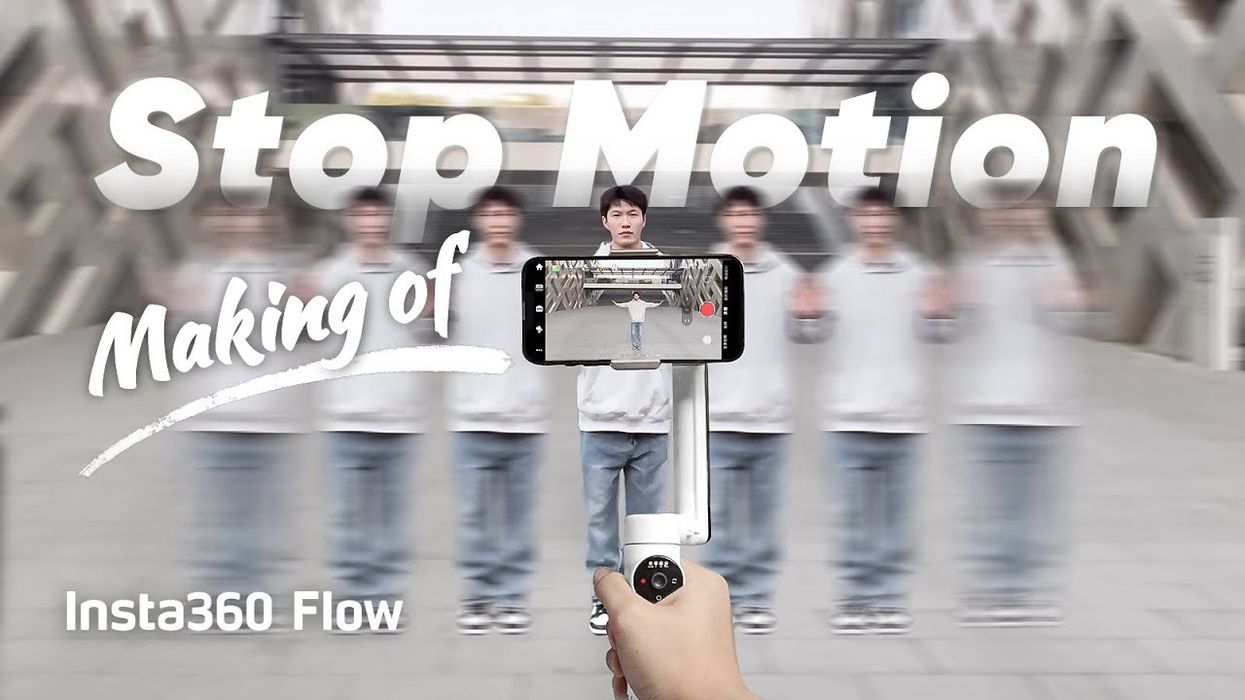How To Shoot Trippy, Yet Easy Stop Motion Videos with a Insta360 Flow
Impress your clients and friends with this super easy, and incredibly cheap, camera trick technique.

Who doesn’t love a good stop-motion video trick? While its uses might be a bit limited to music videos or travel vlog transitions, these stop-motion styles can be great tricks to keep in your back pocket to give any video or project an extra dose of creativity when needed in a pinch.
However, unlike some other more sophisticated camera tricks or editing effects, these stop motion video techniques are not limited to a certain level (or price point) of cameras or gear. And in truth, you can recreate many of these stop motion “videos” with any photo camera or smartphone.
With the Insta360 Flow in mind for this video though, let’s take a look at how you can use this $160 smart gimbal to create some truly impressive stop motion videos with your smartphone, as well as explore how these techniques can become an important part of your filmmaking arsenal.
How to Shoot Stop Motion Videos
As you can see in the video above put out by Insta360 and featuring content creator Winga, these stop-motion videos can be quite fun and even cinematic when done with the right mix of style and editing. It’s cool to see some of the different approaches one can take to basically the same trick too as Winga doesn’t limit himself to just one angle or technique here either.
If you’ve never shot a stop-motion video before, you might be a bit surprised to discover just how easy they are to pull off. These videos are no exceptions as Winga lifts the veil quite nicely on how he was able to create each of these unique video looks by simply having a plan, executing consistently, and taking lots and lots of photos.
Some of the highlights have to be these explanations of the different techniques, which you can find time-coded here:
- 1:54 Linear Stop Motion
- 2:10 Rotating Stop Motion
- 2:25 Lateral Stop Motion
- 3:04 Shooting Problems
- 3:25 Dolly Zoom
Working with the Insta360 Flow
What’s interesting about this video though might simply be the single tool at the heart of Winga’s technique, which would be this Insta360 Flow Smartphone Gimbal Stabilizer. Designed to help stabilize and handle your smartphone’s motion footage, with its compact form factor—as well as a built-in selfie stick and mini tripod—this gimbal is about as easy and smooth as they come.
It’s quite easy to set up and get started with as well, allowing you to mount any smartphone from 2.5” to 3.3” wide in its cradle, and its magnetic holder will allow for it to stay put or quickly unmount when needed. You can also control it with an integrated SmartWheel which you can connect to your camera to provide zoom, trigger, and mode controls and support.
Here are the full specs and features:
- 3-Axis Stabilization for Smooth Footage
- Built-In Selfie Stick and Tripod
- Deep Track 3.0 AI Subject Tracking
- Slow Motion, Zoom Tracking
- SmartWheel Control for Zoom/Mode/Trigger
- 16-Hour Battery, USB-C Charging
- Auto, Follow, Pan Follow FPV Modes
- Magnetic Phone Clamp, 1-Step Deployment
- Panorama and Widescreen Mode
- Edit with Insta360 App
Price: $159.00
Editing Stop Motion Videos
Of course, shooting stop motion video is just one part of the process. The real magic happens in the edit when you stitch all of the images together to create the illusion of movement and video. Depending on how consistent you were out in the field in keeping your frames steady and equal, you’ll either have a lot of work to do here or very little.
Still, even if you were a little unsteady with your images, there are plenty of tricks at your disposal to help track your subject through the different frames to create a smooth video look. In this video, Winga tracks both his subject’s face and feet for consistency, however despite his best efforts even our video creator admits to having to do some image manipulation to keep his subject’s position and posture consistent from shot to shot.
Ultimately though, there are plenty of other tipsand tutorials for shooting stop-motion videos out there. However, if you’re looking for an easy video to try out this trick for the first time, following the steps and techniques above can be a great way to get started.
How do you feel about these stop-motion tricks and techniques though? Anything you’d like to try out yourself? Let us know your thoughts in the comments below.
- Pan/Tilt your iPhone Camera With This Auto-Tracking Stand ›
- Insta360 Ace Pro Adds Active HDR Toggle ›
- Insta360’s Free Desktop Editor Studio Takes Major Step Forward With Latest Update ›
- Use AI-Powered Gesture Controls with the Insta360 X4 ›
- Unlock Apple’s Subject-Tracking Tech with Insta360's iPhone Stabilizer | No Film School ›
- How to Shoot Stop Motion at Home | No Film School ›

 "'Back Home"via Mercedes Arutro
"'Back Home"via Mercedes Arutro 'Back Home'via Mercedes Arutro
'Back Home'via Mercedes Arutro 









